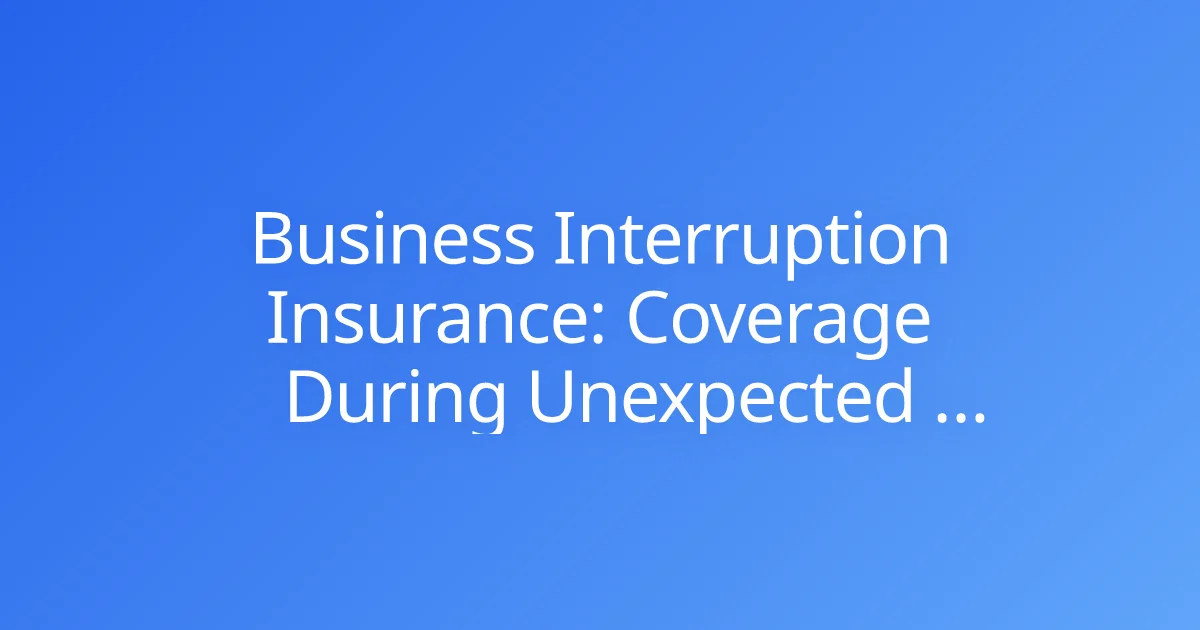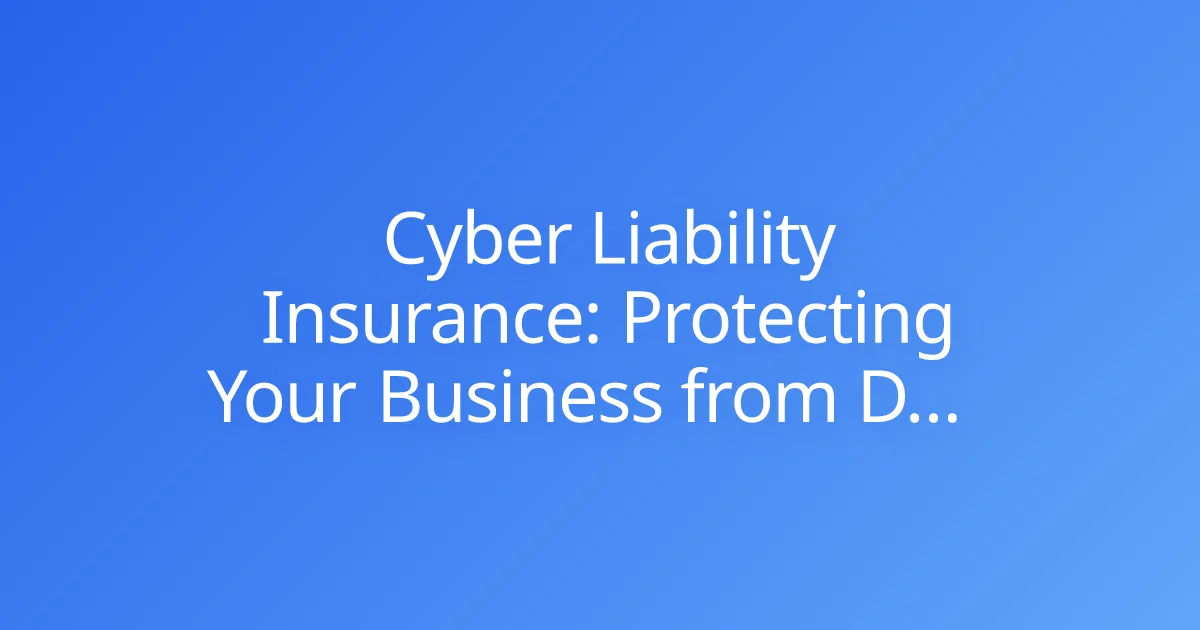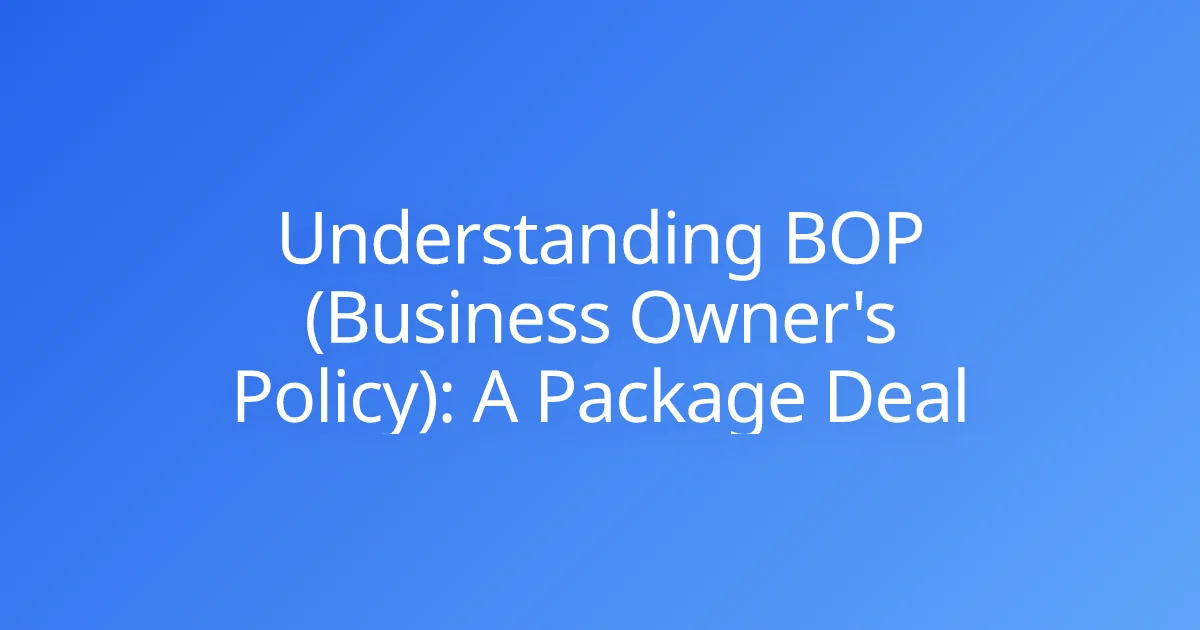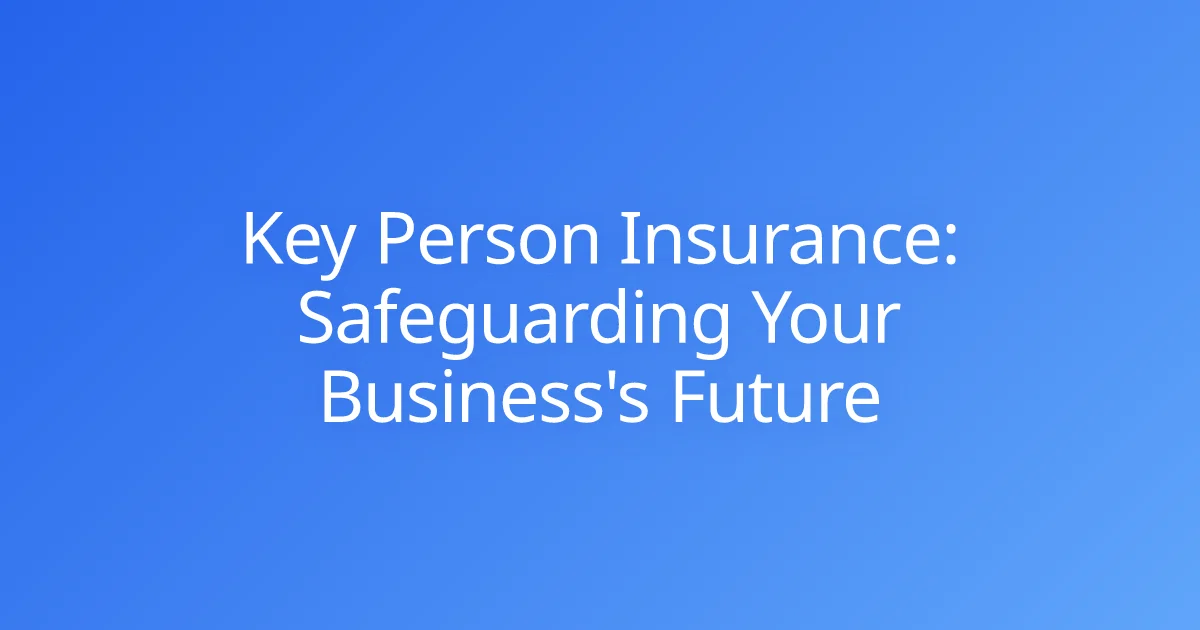Business Interruption Insurance: Coverage During Unexpected Downtime
For any business owner in 2025, the thought of an unexpected closure — whether due to a fire, a cyberattack, extreme weather events, or supply chain disruptions — is a nightmare scenario that has become increasingly common. According to the Federal Emergency Management Agency (FEMA), 40-60% of small businesses never reopen after experiencing a disaster. While property insurance might cover the costs of repairing physical damage, it often overlooks an even more critical concern: the lost income and ongoing operating expenses that continue even when your doors are closed.
Consider this real-world example: In 2024, a family-owned bakery in Texas experienced a kitchen fire that caused $80,000 in property damage. While their property insurance covered the repairs, the business lost $145,000 in revenue during the three-month closure, plus $42,000 in fixed expenses (rent, insurance premiums, and loan payments). Without Business Interruption Insurance, the owners were forced to deplete their personal savings and nearly closed permanently.
At The Policy Explainer, we simplify complex insurance concepts to empower entrepreneurs. This comprehensive guide will illuminate the crucial role of Business Interruption Insurance in 2025's evolving business landscape, detailing exactly what it covers and why it's become even more vital as businesses face new challenges from climate change, supply chain vulnerabilities, and digital dependencies.
What is Business Interruption Insurance? Your Financial Lifeline
Business Interruption Insurance, often referred to as Business Income coverage, is a type of commercial insurance that replaces lost income and covers extra expenses incurred when your business is forced to temporarily close or partially suspend operations due to a covered peril. It's typically included as part of a Commercial Property policy or a Business Owner's Policy (BOP).
In 2025, the average small business experiences downtime costs of $8,600 per hour of closure, according to recent industry data from the Insurance Information Institute. For restaurants, that figure jumps to $12,000 per hour, while manufacturing facilities can lose upward of $25,000 per hour in lost production and contractual penalties.
Think of Business Interruption Insurance as a financial bridge. While your property insurance pays to rebuild your physical space, Business Interruption Insurance ensures that your revenue stream doesn't dry up completely during the period of restoration – the time it takes to repair or rebuild your property and get your business back up and running.
2025 Market Insights
The landscape for Business Interruption Insurance has evolved significantly:
- Premium costs: The average annual premium for Business Interruption coverage ranges from $750 to $2,500 for small businesses, with costs varying based on industry, revenue, and location risk factors
- Claims frequency: Business interruption claims increased by 23% between 2022-2024, driven primarily by extreme weather events and supply chain disruptions
- Coverage gaps: A 2024 survey found that 60% of small business owners either lack adequate Business Interruption coverage or have none at all
Key Terms to Understand:
- Covered Peril: The specific events listed in your policy that trigger coverage, such as fire, severe weather, vandalism, or certain civil authority actions. Exclusions (like floods or earthquakes) typically require separate policies. In 2025, many insurers are offering expanded coverage options for supply chain disruptions and utility outages.
- Period of Restoration: The timeframe during which your business interruption benefits are paid. It usually starts after a waiting period and ends when your business operations are fully restored (or when a specified maximum duration, often 12 months, is reached, whichever comes first). Extended periods of 18-24 months are increasingly common in 2025 policies.
- Waiting Period: A deductible for time, typically 48 or 72 hours, that must pass after the covered peril occurs before business interruption coverage kicks in. Some 2025 policies now offer reduced waiting periods (24 hours) for an additional premium.
When Does Business Interruption Insurance Kick In?
Business Interruption Insurance is activated when your business suffers a direct physical loss or damage to its premises or equipment due to a covered peril, and this damage forces you to suspend or reduce your operations.
Common scenarios where this coverage would apply include:
- Fire: A fire damages your restaurant, making it impossible to operate.
- Storm Damage: A hurricane or tornado destroys your retail store, necessitating extensive repairs.
- Vandalism or Theft: Your office building is extensively vandalized, or critical equipment is stolen, preventing normal operations.
- Burst Pipes/Water Damage: A pipe bursts in your manufacturing facility, flooding the production area and halting operations.
- Civil Authority Orders: If a civil authority (e.g., local government) orders mandatory evacuation or closure of your business premises due to a covered peril (like a gas leak or a nearby fire) in the vicinity, even if your property isn't directly damaged.
It's crucial to note that the trigger for Business Interruption Insurance is typically physical damage from a covered peril. It generally does not cover losses from events like economic downturns, pandemics (unless specifically endorsed and covered, which is rare for standard policies), or government-mandated closures not linked to physical damage to your property or a proximate property.
What Exactly Does Business Interruption Insurance Cover?
The core purpose of Business Interruption Insurance is to put your business in the same financial position it would have been in had the covered event not occurred. This includes both lost revenue and ongoing necessary expenses.
1. Lost Net Income (Profits)
This is the primary benefit, replacing the profits your business would have earned during the period of restoration.
- How it Works: The policy calculates your average historical earnings and pays out the net income you would have generated had the business been operating normally. This is not gross revenue, but revenue minus costs of goods sold.
- Purpose: Ensures your business doesn't suffer a permanent loss of profitability due to temporary closure.
2. Continuing Operating Expenses
Even when your business is closed, many expenses continue. Business Interruption Insurance helps cover these.
- What it Covers: Essential fixed operating expenses that you must continue to pay even when you're not generating revenue, such as:
- Rent or Mortgage Payments: For your business premises.
- Employee Salaries and Benefits: To retain key staff during downtime so they can return when you reopen.
- Loan Payments: For business debts.
- Utility Bills: For basic services.
- Taxes and Insurance Premiums: Ongoing obligations.
- Purpose: Prevents you from falling into deep debt while your business is rebuilding.
3. Extra Expenses
This component covers additional, reasonable costs incurred to minimize the period of interruption and resume operations as quickly as possible.
- What it Covers:
- Relocation Costs: Renting a temporary space.
- Equipment Rental: For temporary operations.
- Overtime Pay: To get your operations back online quickly.
- Advertising Expenses: To inform customers about your reopening.
- Temporary Equipment Purchase: If it helps you reopen faster.
- Purpose: To accelerate recovery and get your business generating revenue again, thereby limiting the overall lost income claim.
Important Additional Coverages (Riders or Endorsements)
Standard Business Interruption Insurance policies may not cover every scenario. You can often add specific endorsements or riders to broaden your protection:
- Contingent Business Interruption (CBI) or Supply Chain Coverage: Protects your business if a covered peril impacts a key supplier or customer, leading to a disruption in your supply chain or demand.
- Example: A fire at your sole raw material supplier's factory prevents them from delivering to you, halting your production.
- Leader Property Coverage: Covers your losses if a nearby anchor business (like a major department store in a shopping mall) suffers a loss and closes, causing your business (which relies on their foot traffic) to experience a loss of income.
- Utility Services Interruption: Covers losses due to disruptions of essential services (power, water, gas) caused by physical damage to the utility provider's property, away from your premises. Standard policies usually only cover outages on your premises.
- Civil Authority Coverage (Extended): Extends coverage beyond the standard limited period for government-mandated closures.
- Extended Period of Indemnity: Extends the period of restoration beyond the typical 12 months, which can be critical for businesses requiring longer recovery times. This pays for lost profits even after physical repairs are complete, until your business returns to its pre-loss level of operations.
Who Needs Business Interruption Insurance?
Virtually any business that relies on a physical location or specific equipment to generate revenue needs Business Interruption Insurance. If you would experience a significant financial hit from a temporary closure, this coverage is essential.
- Retailers: Storefronts that rely on foot traffic and inventory.
- Restaurants & Cafes: Highly dependent on a physical kitchen and dining area.
- Manufacturers: Relies on machinery, production lines, and raw materials.
- Service-Based Businesses with Physical Locations: Salons, spas, gyms, auto repair shops, dry cleaners.
- Professional Offices (if unable to work remotely): Law firms, accounting offices, medical clinics that rely on physical records or specialized equipment.
- Hospitality Businesses: Hotels, motels, B&Bs.
Even a home-based business might need it if essential equipment is destroyed or if local ordinances prevent operation. If your business can continue operating entirely remotely with no physical assets required, the need might be less direct, but Contingent Business Interruption could still be valuable for supply chain risks.
Maximizing Your Business Interruption Coverage: Practical Advice
To ensure your Business Interruption Insurance truly acts as a lifeline, consider these actionable steps:
1. Accurately Calculate Your Potential Losses
Work with your accountant or an insurance professional to determine realistic estimates for:
- Your net income.
- Your ongoing fixed expenses.
- Potential extra expenses during a prolonged closure. This ensures you choose adequate coverage limits. Many businesses underestimate this and find themselves underinsured.
2. Understand Your Policy's Triggers and Exclusions
Read your policy carefully.
- Covered Perils: Know exactly what types of disasters your policy will respond to.
- Waiting Period: Understand the deductible for time and plan for those initial days of financial impact.
- Period of Restoration Limit: Be aware of the maximum duration your benefits will be paid (e.g., 12, 18, or 24 months) and consider an Extended Period of Indemnity endorsement if your recovery might take longer.
- Exclusions: Be clear on what is not covered, such as pandemics, specific natural disasters (like floods), or utility failures off-premises, so you can explore additional coverage if needed.
3. Consider Additional Endorsements
Discuss with your insurance agent whether Contingent Business Interruption, Leader Property, or Utility Services Interruption endorsements are relevant to your business, especially if you rely heavily on specific suppliers, anchor tenants, or public infrastructure.
4. Implement a Business Continuity Plan (BCP)
Insurance is one part of the puzzle; a comprehensive BCP helps you mitigate losses and recover faster.
- Data Backups: Regularly back up all critical data off-site.
- Emergency Contacts: Have an up-to-date list of key contacts (employees, vendors, clients).
- Remote Work Capabilities: Explore options for employees to work from home if possible.
- Temporary Location Plan: Identify potential temporary operating spaces in advance.
- Supplier Diversification: Reduce reliance on a single supplier if possible.
5. Review Your Policy Annually
As your business grows and evolves, so do its risks and financial needs. Review your Business Interruption Insurance policy annually with your insurance provider to ensure your coverage limits and endorsements remain appropriate.
2025 Trends in Business Interruption Coverage
The business insurance landscape is evolving rapidly to address emerging risks:
Climate Change and Extreme Weather Coverage
With increasingly frequent and severe weather events, insurers are:
- Offering parametric coverage that pays out based on weather data triggers
- Providing specialized hurricane and wildfire extensions
- Including climate resilience assessments as part of underwriting
Supply Chain Disruption Coverage
The global supply chain crisis of 2020-2023 highlighted critical gaps. In 2025, enhanced coverage includes:
- Contingent Business Interruption for multiple suppliers: Protection when 2+ key suppliers are affected simultaneously
- Time Element Extensions: Coverage periods extended to 18-24 months to account for longer supply chain recovery times
- International supplier coverage: Protection for overseas manufacturing disruptions
Cyber-Physical Convergence
Modern businesses face risks where cyber incidents cause physical operational disruptions:
- Ransomware attacks that shut down physical operations
- IT system failures preventing manufacturing or retail operations
- Coordinated cyber-physical attacks on critical infrastructure
Many 2025 policies now offer hybrid coverage addressing both cyber and physical business interruption.
Remote Work Considerations
Post-pandemic work models have created new considerations:
- Coverage for distributed workforce scenarios
- Protection when home-based operations become unavailable
- Dependent property coverage for co-working spaces
Business-Specific Coverage Checklist
For Restaurants and Food Service
- Spoilage coverage for inventory loss during power outages
- Equipment breakdown coverage for critical refrigeration
- Civil authority coverage for health department closures
- Contamination coverage for foodborne illness incidents
- Utility services interruption (water, gas, electric)
Real example: A Miami restaurant chain with proper Business Interruption coverage received $385,000 after Hurricane Milton caused a 6-week closure in 2024, covering lost revenue, employee salaries, and promotional costs for reopening.
For Retail Businesses
- Coverage for seasonal revenue fluctuations
- Leader property coverage (anchor store closure impact)
- Ingress/egress coverage (blocked customer access)
- Extended period of indemnity (post-reopening revenue recovery)
- Civil authority coverage
Real example: A boutique in Portland received $127,000 when civil unrest blocked customer access for 3 months, despite no physical damage to their property.
For Manufacturing
- Equipment breakdown and machinery coverage
- Contingent business interruption (supplier/customer coverage)
- Expediting expenses (rush shipping, overtime labor)
- Research and development work coverage
- Contract penalty coverage
ROI example: A manufacturing company paid $4,200 annually for Business Interruption coverage. When a fire caused $2.1 million in lost production over 4 months, the insurance paid $1.9 million, saving the business from bankruptcy.
For Professional Services
- Extended waiting period options (longer than standard 72 hours)
- Extra expense coverage for temporary office space
- Technology/data recovery expenses
- Accounts receivable coverage
- Dependent property coverage for key clients
For E-Commerce and Digital Businesses
- Cyber business interruption coverage
- Third-party cloud service provider outage coverage
- Digital asset restoration costs
- Payment processor failure coverage
- Reputational harm mitigation expenses
Frequently Asked Questions
Q: Does Business Interruption Insurance cover pandemic-related closures in 2025?
A: Standard policies typically exclude communicable disease-related closures following the COVID-19 pandemic. However, some insurers now offer specialized communicable disease endorsements as optional add-ons, typically with sub-limits of $50,000-$250,000 and higher premiums. Always review your policy's specific exclusions.
Q: How is my coverage limit calculated?
A: Your coverage limit should equal approximately 12-24 months of gross earnings plus fixed expenses. Work with your accountant to calculate: (Annual Revenue - Variable Costs) + Fixed Expenses = Recommended Coverage Amount. For a business with $800,000 annual revenue, $300,000 in variable costs, and $200,000 in fixed expenses, you'd need approximately $700,000 in coverage.
Q: What's the difference between actual loss sustained and agreed value coverage?
A: Actual loss sustained pays based on your real financial losses up to your policy limit. Agreed value (also called valued form) pays a predetermined amount regardless of actual losses. Most businesses opt for actual loss sustained, but agreed value can be beneficial for businesses with highly variable income.
Q: Will Business Interruption Insurance cover lost future opportunities?
A: Standard policies cover documented lost income during the restoration period but typically don't cover speculative future business. However, extended period of indemnity endorsements can cover the time needed to return to pre-loss revenue levels, which may extend 3-12 months beyond physical restoration.
Q: How quickly do claims typically pay out?
A: Initial advance payments often occur within 2-4 weeks after filing. Full settlement depends on complexity but averages 3-6 months. Consider requesting advance payment provisions in your policy to access funds quickly during closure.
Q: Can I get coverage if I run a home-based business?
A: Yes, though standard homeowners policies typically don't include adequate business interruption coverage. You'll need either a home business policy endorsement or a separate Business Owner's Policy. Coverage limits for home-based businesses typically range from $25,000 to $250,000.
Q: What documentation do I need to file a claim?
A: Essential documents include: financial statements (2-3 years of tax returns, profit/loss statements), current payroll records, utility bills, lease/mortgage agreements, customer contracts, and detailed records of the incident. Many businesses also hire forensic accountants to document losses, with costs typically covered by the policy.
Maximizing Your Coverage: 2025 Best Practices
1. Conduct Annual Coverage Reviews
Your business changes—revenue grows, you add locations, modify operations. Review coverage annually to ensure your policy limits reflect current needs. A business that's grown 40% in revenue but hasn't updated coverage faces serious underinsurance risk.
2. Document Everything
Maintain detailed records:
- Monthly/quarterly financial statements
- Inventory valuations
- Customer contracts and recurring revenue agreements
- Photos and videos of your premises and equipment
- Updated business continuity plans
Expert tip: Use cloud-based accounting software that automatically backs up financial data. In a disaster, having 3+ years of financial history immediately accessible accelerates claims processing by 60-90 days.
3. Calculate Coverage Based on Peak Periods
If your business has seasonal peaks, base coverage on your busiest periods. A ski resort that calculates coverage based on summer revenue will be drastically underinsured during a winter closure.
4. Understand Policy Exclusions and Endorsements
Common exclusions in 2025:
- Ordinance or law upgrades (unless specifically endorsed)
- Pandemic/communicable disease (unless specifically endorsed)
- Nuclear incidents
- War and terrorism (unless specifically endorsed)
- Intentional acts
Consider adding:
- Utility services interruption (off-premises): $150-400 annually
- Civil authority extension: $200-500 annually
- Extended period of indemnity: $300-800 annually
- Contingent business interruption: $500-1,500 annually
5. Coordinate with Other Coverages
Ensure your Business Interruption coverage coordinates properly with:
- Commercial property insurance: Both should have consistent valuation methods
- Cyber liability insurance: Understand where coverage transitions between policies
- Equipment breakdown coverage: Often bundled but verify coverage triggers
- Commercial umbrella insurance: For catastrophic scenarios exceeding base limits
Real-World ROI Examples
Case Study 1: Tech Startup Saves $890,000
A software-as-a-service company in Austin experienced a data center fire that knocked out their primary servers for 6 weeks. Their $3,200 annual Business Interruption premium resulted in a claim payout of $920,000, covering:
- $685,000 in lost subscription revenue
- $145,000 in fixed expenses (salaries, office rent, cloud hosting fees)
- $90,000 in extra expenses (emergency AWS migration, customer communications, expedited hardware)
ROI: 28,625% return on their premium investment
Case Study 2: Retail Store Survives Civil Authority Closure
When a gas main explosion forced authorities to close a 6-block radius for 45 days, a boutique clothing store received $156,000 despite having zero physical damage. Their coverage included civil authority endorsement, which cost an extra $285 annually.
ROI: 54,639% return on the endorsement cost
Case Study 3: Manufacturing Facility Avoids Bankruptcy
A furniture manufacturer faced a 4-month closure after tornado damage. Beyond the $1.2M in property damage repairs, they received:
- $1.8M for lost production revenue
- $340,000 in continuing employee salaries
- $285,000 in loan payments and fixed expenses
- $125,000 in expediting expenses to fulfill urgent customer orders from a temporary facility
Their annual Business Interruption premium was $8,400. The coverage prevented bankruptcy and saved 47 jobs.
ROI: 30,357% return on premium
Industry-Specific Expertise: What Underwriters Look For in 2025
Insurers now use sophisticated risk modeling when underwriting Business Interruption policies:
Risk Factors That Increase Premiums
- Locations in high-risk disaster zones (hurricane, earthquake, wildfire regions)
- Single-supplier dependencies
- Seasonal revenue concentration (>60% in one quarter)
- Outdated infrastructure or equipment
- No documented business continuity plan
Factors That Reduce Premiums
- Diversified supplier relationships
- Documented disaster recovery plans
- Regular equipment maintenance programs
- Multiple location operations
- Robust cybersecurity measures
- Installation of sprinkler systems, fire suppression equipment
Expert insight: Businesses that implement and document comprehensive business continuity plans can reduce Business Interruption premiums by 10-25%.
Integration with Business Continuity Planning
Business Interruption Insurance works best as part of a comprehensive resilience strategy:
Essential BCP Components
- Risk Assessment: Identify critical business functions and potential disruption scenarios
- Recovery Time Objectives (RTO): Define maximum acceptable downtime for each function
- Alternative Operating Procedures: Document workarounds for key operations
- Communication Plans: Templates for customer, employee, and vendor notifications
- Financial Reserves: Maintain 30-90 days of operating capital
- Vendor Agreements: Pre-negotiate temporary space, equipment rental agreements
- Insurance Coordination: Ensure BCP aligns with policy coverage and claims documentation requirements
Actionable tip: Schedule annual disaster simulation exercises. Businesses that regularly test their BCPs file claims 40% faster and return to full operations 35% quicker than those without testing protocols.
Related Coverage Considerations
Business Interruption Insurance integrates with other essential commercial coverages:
- General Liability Insurance: Protects against third-party injury claims
- Cyber Liability Insurance: Covers digital business interruptions
- Business Owner's Policy (BOP): Bundles property, liability, and business interruption coverage
- Workers' Compensation: Protects employees and your business during incidents
Conclusion
In 2025's unpredictable business landscape, Business Interruption Insurance stands as a crucial safeguard, offering essential coverage during unexpected downtime that has saved thousands of businesses from permanent closure. It ensures that a physical disaster, supply chain disruption, or civil authority order doesn't automatically translate into a financial catastrophe, protecting your lost income and covering vital operating expenses during the challenging period of restoration.
The statistics are sobering: businesses without adequate Business Interruption coverage are 3.5 times more likely to close permanently after a major disruption. With the average claim payout of $167,000 for small businesses and premiums averaging just $1,200-2,000 annually, the ROI is undeniable.
By understanding what it covers, recognizing its importance for your specific operations, staying informed about 2025 trends like climate resilience and supply chain protection, and taking proactive steps to align your policy with your business's needs, you invest in its resilience and long-term viability. This foresight provides the financial stability necessary to weather any storm and confidently rebuild, allowing your business to thrive even after the most unforeseen challenges.
Ready to protect your business? Contact a specialized commercial insurance broker to assess your Business Interruption coverage needs, review your current policy for gaps, and ensure you have the protection necessary to survive and thrive in 2025's evolving risk landscape.



